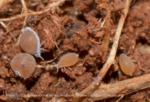Common name
Scientific name
Tetraneura nigriabdominalis SasakiWhat it does
Adult and nymph root aphids suck the plant to remove fluids. The feeding damage causes yellowing of leaves and stunting.
Why and where it occurs
Rice root aphids are favored by drought. During this period, aphid populations occur unevenly.
Rice root aphids are dominant in well-drained soils in upland and rainfed rice. They are not present in irrigated rice. The adults are found on roots below ground level. They can also be located in cavities made by ants around the root system. The nymphs produce honeydew, which attracts ants. In return, ants transport the nymphs from plant to plant, protecting the growing aphids from predators and parasites.
How to identify
Symptoms of root aphid feeding damage are:
- Leaf yellowing
- Stunting if infestation is very severe
Except for the yellowing of the plant, stunting can be compared with the damage caused by root grubs.
To confirm cause of damage, check for aphids feeding in the roots.
- globular and tan or brown nymphs
- greenish, to brownish white, to yellow, to dark orange adults feeding on plants
Click on images to enlarge
How to manage
- Biological control agents: small braconid wasp, mermithid nematode
Learn more
View full fact sheet:
Root aphids on IRRI Rice Knowledge Bank



